Main contents start here
3. Types of Places for Purchasing by Item
(i) Overview
A look at the types of places for purchasing by item shows that supermarkets accounted for 56.6% of monthly average food purchases per household at 35,003 yen and retail stores accounted for 16.0% at 9,903 yen. Together these retail outlets accounted for more than 70% of foodstuff purchases.
Discount stores/mass sales speciality stores accounted for 29.9% of purchases of furniture & household utensils at 2,858 yen, followed by retail stores accounting for 25.6% at 2,447 yen and supermarkets accounting for 21.0% at 2,006 yen. Discount stores stores/mass sales speciality stores show a larger purchase ratio of furniture & household utensils as compared to other items.
Department stores accounted for 35.1% of purchases of clothes & footwear, at 5,037 yen, followed by retail stores accounting for 27.4% at 3,934 yen and supermarkets accounting for 17.0% at 2,431 yen. Department stores exhibit a higher purchase ratio of clothing & footwear as compared to other items.
Retail stores accounted for 49.2% of purchases of reading & recreation items at 7,102 yen followed by discount stores accounting for 22.5% at 3,242 yen and supermarkets accounting for 10.1% at 1,456 yen.
Of the total purchase amount of 7,162 yen of miscellaneous items including hair styling products and cosmetics, retail stores accounting for 31.4% at 2,249 yen followed by supermarkets accounting for 17.2% at 1,231 yen and department stores accounting for 15.5% at 1,111 yen.
The 2004 survey has newly included the investigation of mail-order purchases made using the Internet. The ratios of purchases made using the Internet by item, as follows : food at 0.2%, furniture & household utensils at 1.2%, clothes & footwear at 0.9%, reading & recreation at 2.0% and miscellaneous items at 1.2% indicating these purchases remained at low levels as compared to other types of places for purchasing. (Table V-3)
Table V-3: Average Monthly Living Expenditure by Type of Places for Purchasing and Item (All Households)
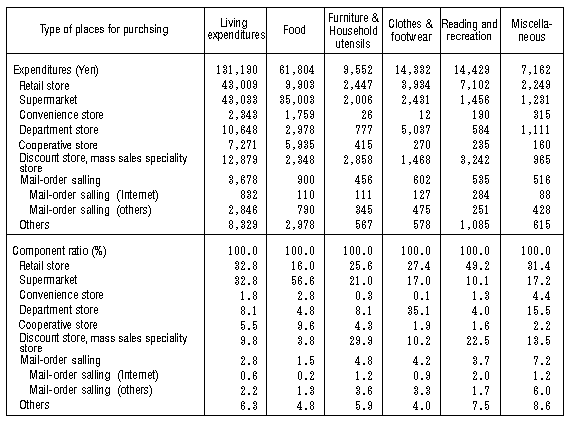
(ii) Changes in Expenditure Ratios by Type of Places for Purchasing
A look at changes in the expenditure ratios by item and by type of places for purchasing reveals that purchases of food at retail stores consistently declined from 44.3% in 1984 to 16.0% in 2004. After edging up from 3.4% in 1984 to 4.9% in 1999, purchases of food at department stores slowed down to 4.8% in 2004. On the other hand, purchases of food at supermarkets consistently from 42.0% in 1984 to 56.0% in 2004. Purchases of food at cooperative stores also generally increased from 6.1% in 1984 to 9.6% in 2004. Moreover, purchases of food at convenience stores, discount stores/mass sales speciality stores and mail-order selling were consistently on the increase.
Purchases of furniture & household utensils at retail stores steadily declined from 49.9% in 1984 to 25.6% in 2004. Department stores also saw retreat in sales of these goods from 14.1% in 1984 to 8.1% in 2004. After edging up from 21.8% in 1984 to 25.6% in 1999, purchases of furniture & household utensils at supermarkets fell to 21.0% in 2004. On the other hand, purchases of these products at discount stores/mass sales speciality stores consistently rose from 11.6% in 1994 to 29.9% in 2004.
Purchases of clothes & footwear at retail stores declined at a steady pace from 39.1% in 1984 to 27.4% in 2004. Supermarkets also recorded a decline in purchases of these items from 19.5% in 1999 to 17.0% in 2004. Moreover, purchases of these products at department stores edged down from 37.2% in 1999 to 35.1% in 2004. On the other hand, discount stores/mass sales speciality stores enjoyed a steady increase in purchases of these goods from 2.8% in 1994 to 10.2% in 2004. Purchases of the same products also increased at mail-order selling from 3.8% in 1994 to 4.2% in 2004.
Purchases of reading & recreation items at retail stores consistently declined from 69.7% in 1984 to 49.2% in 2004. Department stores also experienced downturn in purchases of these products from 7.7% in 1984 to 4.0% in 2004. After growing from 8.5% in 1984 to 12.7% in 1999, purchases of reading & recreation items at supermarkets dropped to 10.1% in 2004. On the other hand, purchases of reading & recreation items at discount stores/mass sales speciality stores constantly rose from 7.2% in 1994 to 22.5% in 2004. Mail-order selling also saw an increase in purchases of these items from 1.8% in 1994 to 3.7% in 2004.
Purchases of miscellaneous items including toilet articles fell at a steady pace from 60.5% in 1984 to 31.4% in 2004. After ascending from 13.7% in 1984 to 17.9% in 1999, purchases of miscellaneous items at supermarkets eased off to 17.2% in 2004. On the other hand, discount stores/mass sales specility stores saw a sustained growth in purchases of miscellaneous items from 3.7% in 1994 to 13.5% in 2004. Purchases of miscellaneous items from mail-order selling expanded from 2.8% in 1994 to 7.2% in 2004 and those at department stores also rose from 13.9% in 1999 to 15.5% in 2004. (Table V-4)
Table V-4: Changes in Ratios by Item and Type of Places for Purchasing (All Households)

(iii) Food
An analysis of the food items with higher purchase ratio (expenditures ratio at a given type of places for purchasing) by type of places for purchasing reveals that green tea had the highest ratio of 34.8% at retail stores followed by "sake" at 33.4% and bread like sandwiches put cooked food between bread at 32.7%.
At supermarkets, instant curry mix showed the highest purchase ratio at 81.8%, which was followed by Worcester sauce & tomato ketchup and margarine both at 78.5% with oils, fats and condiments exhibiting higher ratios.
At convenience stores, "onigiri" and others had the highest purchase ratio at 39.7% followed by packed lunch at 25.4% and bread like sandwiches put cooked food between bread at 21.2%.
At department stores, black tea took up the highest purchase ratio at 19.7% followed by vegetables & seaweed prepared in soy sauce at 17.2% and dried laver at 15.1%.
At cooperative stores, frozen foods had the highest purchase ratio at 28.0% followed by miscellany of other processed vegetables & seaweeds including canned vegetables at 16.2% and other processed fish including dried bonito in pack and canned fish & shellfish at 15.6%.
At discount stores/mass sales speciality stores, powdered milk exhibited the highest purchase ratio at 45.9% followed by whisky at 31.1%, happo-shu at 27.9% with alcoholic beverages having higher ratios.
At mail-order selling (on the Internet), coffee had the highest purchase ratio at 2.3% followed by other tea leaves including health supplement tea at 2.2% and vinegar at 1.7%. However, the purchase ratios at these places of purchasing were low as compared to other types of places for purchasing.
At mail-order selling (others), food stuff for cooking showed the highest purchase ratio at 38.8% followed by mineral water at 11.6% and other places for purchasing at 10.8%. (Table V-5)
Table V-5: Items with High Purchase Ratio by Type of Places for Purchasing in Food (All Households)
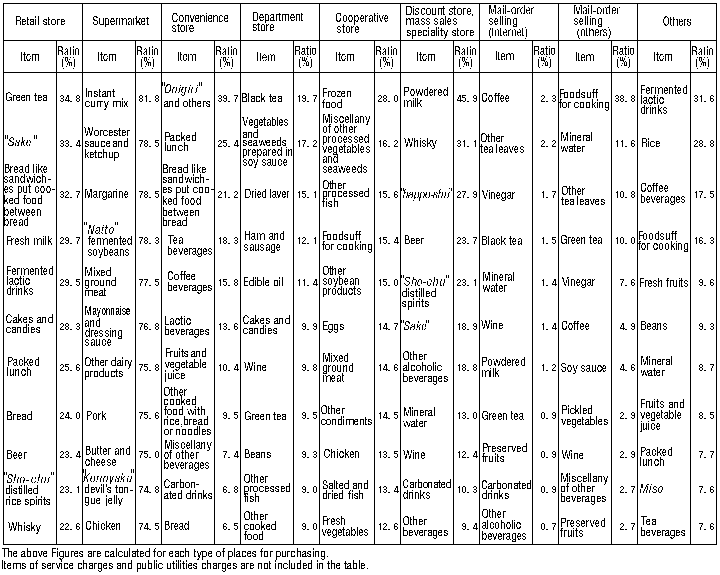
(iv) Furniture & Household Utensils
An analysis of the furniture & household utensils with higher purchase ratio by type of places for purchasing reveals that beds had the highest ratio of 59.0% at retail stores, followed by gas cooking appliances at 57.8% and air conditioners at 53.2%.
At supermarkets, polyethylene bags & food wraps showed the highest purchase ratio at 59.4% followed by facial tissue & rolled toilet paper at 50.6%, detergent (laundry), and detergent (house and kitchen) at 44.4% with domestic durable goods exhibiting higher ratios.
At convenience stores, polyethylene bags & food wraps had the highest purchase ratio at 1.7% followed by "other domestic durable goods" at 0.8%. Thereafter, the three items of detergent (house and kitchen), detergent (laundry) and facial tissue & rolled toilet paper showed the same ratio of 0.7%. However, convenience stores handle limited range of furniture & household utensils and the purchase ratio of these items was generally low at these stores.
At department stores, blankets and tableware took up the highest purchase ratio at 23.8% followed by floor coverings at 21.3%.
At cooperative stores, quilts had the highest purchase ratio at 8.8% followed by facial tissue & rolled toilet paper at 8.5% and kitchen items at 7.6%.
At discount stores/mass sales speciality stores, microwave ovens exhibited the highest purchase ratio at 56.0% followed by refrigerators at 55.0% and washing machines & clothes dryers at 54.1% with domestic durable goods having higher ratios.
At mail-order selling (on the Internet), microwave ovens had the highest purchase ratio at 5.5% followed by "other heating & cooling appliances" at 3.7% and dining suites at 2.7%.
At mail-order selling (others), sewing machines showed the highest purchase ratio at 15.8% followed by blankets at 15.1% and "other beddings" at 10.2%. (Table V-6)
Table V-6: Items with High Purchase Ratio by Type of Places for Purchasing in Furniture and Household Utensils (All Households)
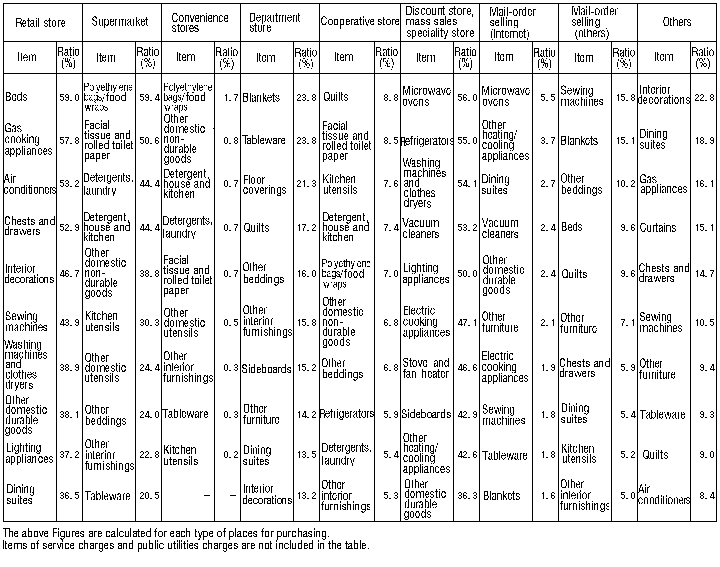
(v) Clothes & Footwear
An analysis of the clothes & footwear items with higher purchase ratio by type of places for purchasing reveals that school uniform for boys had the highest ratio of 68.2% at retail stores followed by women's Japanese clothing at 54.7% and children's Japanese clothing at 54.5% with various types of Japanese clothing exhibiting higher ratios.
At supermarkets, men's underwear showed the highest purchase ratio at 40.9% followed by children's underwear at 39.0%. Thereafter, children's socks and women's socks both exhibited the same purchase ratio of 37.8% with underwear items showing higher ratios.
At convenience stores, women's socks took up the highest purchase ratio at 1.2% followed by men's socks at 0.6% and "other footwear" including sandals at 0.5%. However, convenience stores handle limited range of clothes & footwear items and the purchase ratio of these items were generally low.
At department stores, women's coats had the highest purchase ratio at 57.4% followed by women's clothing at 54.4% and men's coats at 52.2%.
At cooperative stores, women's socks had the highest purchase ratio at 5.0% followed by men's underwear at 4.7% and men's socks at 4.6%.
At discount stores/mass sales speciality stores, "other footwear" exhibited the highest purchase ratio at 21.3% followed by men's suits, canvas shoes and children's underwear all having the same purchase ratio of 19.2%.
At mail-order selling (on the Internet), children's sweaters had the highest purchase ratio at 2.0% followed by "other women's clothing" at 1.9%. Thereafter, other women's shirts and cloth & thread exhibited the same purchase ratio of 1.5%.
At mail-order selling (others), "other women's clothing" showed the highest purchase ratio at 7.7% followed by women's underwear at 7.1% and women's slacks at 4.7% with women's clothing items exhibiting higher ratios. (Table V-7)
Table V-7: Items with High Purchase Ratio by Type of Places for Purchasing in Clothes and Footwear(All Households)
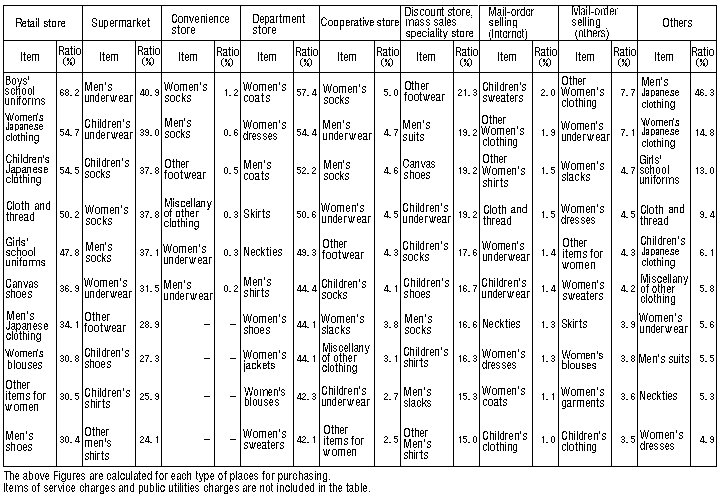
(vi) Reading & recreation
An analysis of reading & recreation items with higher purchase ratio by type of places for purchasing reveals that newspaper had the highest ratio of 90.8% at retail stores followed by "other reading materials" at 59.6% and desks and chairs for students and office workers at 59.0%.
At supermarkets, pet foods showed the highest purchase ratio at 36.1% followed by batteries at 35.2% and stationery non-durables including pencils and erasers.
At convenience stores, magazines & weekly magazines had the highest purchase ratio at 14.8% followed by films at 10.5% and TV game machines at 4.4%.
At department stores, "other toys" excluding TV game machines took up the highest purchase ratio at 18.0% followed by sporting goods at 16.9% and "other items of reading & recreation" at 9.9%.
At cooperative stores, "other reading materials" had the highest purchase ratio at 6.4% followed by prerecorded recording media such as CDs and DVDs at 6.2% and garden plants & gardening goods at 5.5%.
At discount stores/mass sales speciality stores, equipment for receiving, recording and play-back of sound and pictures (portable) such as portable MDs exhibited the highest purchase ratio at 67.6% followed by stereo phonograph sets at 66.0% and video cameras at 63.8% with recreational durable goods exhibiting higher ratios.
At mail-order selling (on the Internet), stereo phonograph sets had the highest purchase ratio at 10.0% followed by PCs at 9.1% and prerecorded recording media at 6.5%.
At mail-order selling (others), musical instruments showed the highest purchase ratio at 14.8% followed by prerecorded recording media at 10.2%. Thereafter, magazines & weekly magazines and video cameras had the same purchase ratio of 5.0%. (Table V-8)
Table V-8: Items with High Purchase Ratio by Type of Places for Purchasing in Reading and Recreation (All Households)
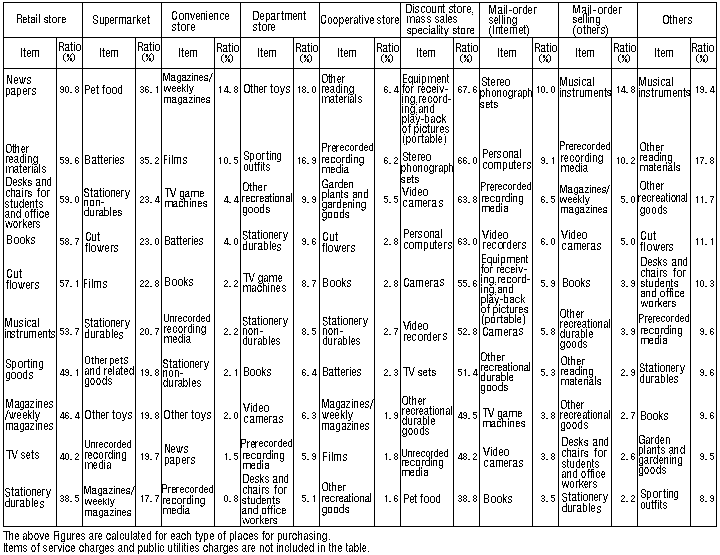
(vii) Miscellaneous
An analysis of the miscellaneous items with higher purchase ratio by type of places for purchasing reveals that family alter and gravestones had the highest purchase ratio of 75.3% at retail stores followed by accessories at 40.9% and wrist watches at 40.6%.
At supermarkets, shampoo & toothpaste showed the highest purchase ratio at 40.4% followed by umbrellas at 33.3% and bath & facial soap at 31.9%.
At convenience stores, tobacco had the highest purchase ratio at 24.3% followed by umbrellas at 2.4% and hairdressing liquid at 1.3%.
At department stores, bags took up the highest purchase ratio at 48.5% followed by accessories at 38.1% and other personal effects at 37.0%.
At cooperative stores, bath & facial soap had the highest purchase ratio at 6.3% followed by other toilet articles at 5.7% and shampoo & toothpaste at 4.2%.
At discount stores/mass sales speciality stores, electric appliances for personal care exhibited the highest purchase ratio at 54.3% followed by hairdressing liquid at 34.4% and shampoo & toothpaste at 32.5%.
At mail-order selling (on the Internet), electric appliances for personal care had the highest purchase ratio at 3.8% followed by wrist watches at 3.1% and other personal effects at 1.9%.
At mail-order selling (others), cosmetics showed the highest purchase ratio at 12.2% followed by accessories at 5.6% and bath & facial soap at 5.5%. (Table V-9)
Table V-9: Items with High Purchase Ratio by Type of Places for Purchasing in Miscellaneous Item (All Households)
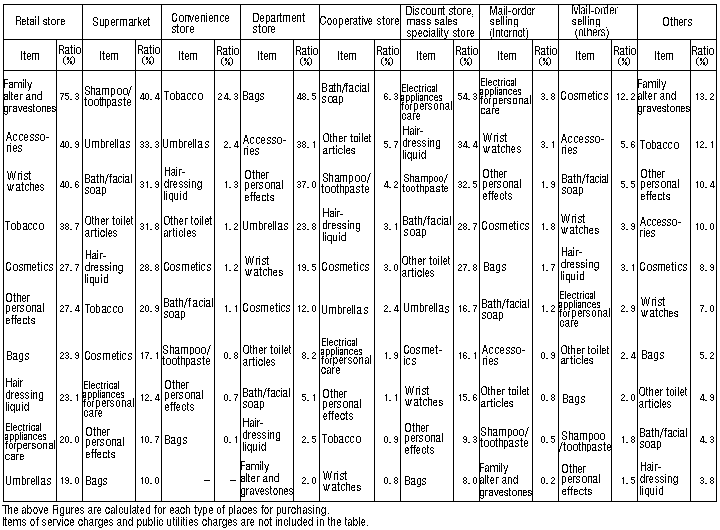
(viii) Mail-Order Selling (on the Internet)
An analysis of the purchase ratios in transactions made using mail-order selling (on the Internet) by item shows that stereo phonograph sets has the highest ratio at 10.0% followed by PCs at 9.1%, prerecorded recording media such as CDs and DVDs, video cassette recorders at 6.0%, equipment for receiving, recording and play-back of sound and pictures (portable) such as portable MDs at 5.9% with recreational durable goods showing higher ratios. (Table V-10)
Table V-10: Items with High Purchase Ratio in Transactions Made Using Mail-Order Selling (the Internet) (All Households)
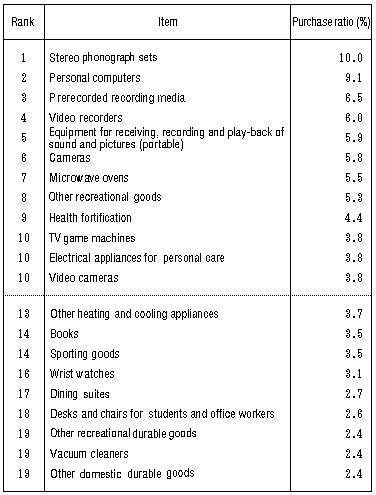
Go to V-4. Purchase Ratios by Type of Places for Purchasing and Age Group of Household Heads
